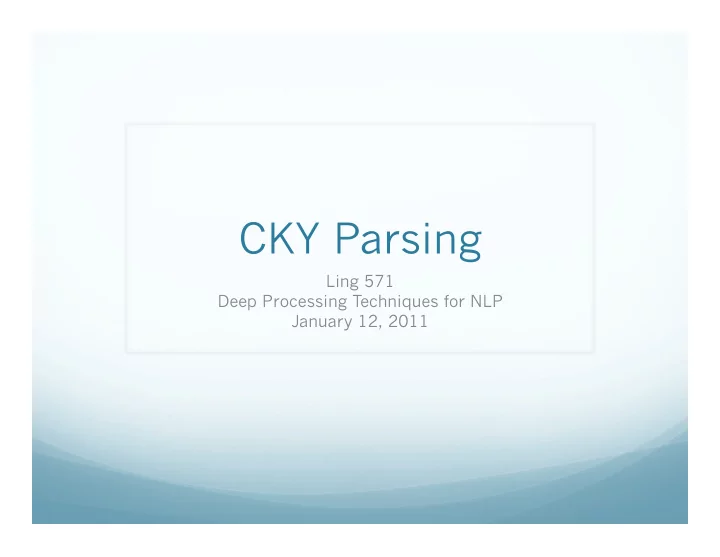

CKY Parsing Ling 571 Deep Processing Techniques for NLP January 12, 2011
Roadmap Motivation: Parsing (In) efficiency Dynamic Programming Cocke-Kasami-Younger Parsing Algorithm Chomsky Normal Form Conversion CKY Algorithm Parsing by tabulation
Repeated Work Top-down and bottom-up parsing both lead to repeated substructures Globally bad parses can construct good subtrees But overall parse will fail Require reconstruction on other branch No static backtracking strategy can avoid Efficient parsing techniques require storage of shared substructure Typically with dynamic programming Example: a flight from Indianapolis to Houston on TWA
Bottom-Up Search
Dynamic Programming Challenge: Repeated substructure -> Repeated work Insight: Global parse composed of parse substructures Can record parses of substructures Dynamic programming avoids repeated work by tabulating solutions to subproblems Here, stores subtrees
Parsing w/Dynamic Programming Avoids repeated work Allows implementation of (relatively) efficient parsing algorithms Polynomial time in input length n 3 Typically cubic ( ) or less Several different implementations Cocke-Kasami-Younger (CKY) algorithm Earley algorithm Chart parsing
Chomsky Normal Form (CNF) CKY parsing requires grammars in CNF Chomsky Normal Form All productions of the form: A -> B C, or A -> a However, most of our grammars are not of this form E.g., S -> Wh-NP Aux NP VP Need a general conversion procedure Any arbitrary grammar can be converted to CNF
Grammatical Equivalence Weak equivalence: Recognizes same language Yields different structure Strong equivalence Recognizes same languages Yields same structure CNF is weakly equivalent
CNF Conversion Three main conditions: Hybrid rules: INF-VP -> to VP Unit productions: A -> B Long productions: A -> B C D
CNF Conversion Hybrid rule conversion: Replace all terminals with dummy non-terminals E.g., INF-VP -> to VP INF-VP -> TO VP; TO -> to Unit productions: Rewrite RHS with RHS of all derivable non-unit productions " If and B -> w, then add A -> w A ! B
CNF Conversion Long productions: Introduce new non-terminals and spread over rules S -> Aux NP VP S -> X1 VP; X1 -> Aux NP For all non-conforming rules, Convert terminals to dummy non-terminals Convert unit productions Binarize all resulting rules
CKY Parsing Cocke-Kasami-Younger parsing algorithm: (Relatively) efficient bottom-up parsing algorithm based on tabulating substring parses to avoid repeated work Approach: Use a CNF grammar Build an (n+1) x (n+1) matrix to store subtrees Upper triangular portion Incrementally build parse spanning whole input string
Dynamic Programming in CKY Key idea: For a parse spanning substring [i,j] , there exists some k such there are parses spanning [i,k] and [k,j] We can construct parses for whole sentence by building up from these stored partial parses So, To have a rule A -> B C in [i,j], We must have B in [i,k] and C in [k,j], for some i<k<j CNF grammar forces this for all j>i+1
CKY Given an input string S of length n, Build table (n+1) x (n+1) Indexes correspond to inter-word positions W.g., 0 Book 1 That 2 Flight 3 Cells [i,j] contain sets of non-terminals of ALL constituents spanning i,j [j-1,j] contains pre-terminals If [0,n] contains Start, the input is recognized
CKY Algorithm
Is this a parser?
CKY Parsing Table fills: Column-by-column Left-to-right Bottom-to-top Why? Necessary info available (below and left) Allows online sentence analysis Works across input string as it arrives
CKY Table Book the flight through Houston
Filling CKY cell
From Recognition to Parsing Limitations of current recognition algorithm:
From Recognition to Parsing Limitations of current recognition algorithm: Only stores non-terminals in cell Not rules or cells corresponding to RHS
From Recognition to Parsing Limitations of current recognition algorithm: Only stores non-terminals in cell Not rules or cells corresponding to RHS Stores SETS of non-terminals Can’t store multiple rules with same LHS
From Recognition to Parsing Limitations of current recognition algorithm: Only stores non-terminals in cell Not rules or cells corresponding to RHS Stores SETS of non-terminals Can’t store multiple rules with same LHS Parsing solution: All repeated versions of non-terminals
From Recognition to Parsing Limitations of current recognition algorithm: Only stores non-terminals in cell Not rules or cells corresponding to RHS Stores SETS of non-terminals Can’t store multiple rules with same LHS Parsing solution: All repeated versions of non-terminals Pair each non-terminal with pointers to cells Backpointers
From Recognition to Parsing Limitations of current recognition algorithm: Only stores non-terminals in cell Not rules or cells corresponding to RHS Stores SETS of non-terminals Can’t store multiple rules with same LHS Parsing solution: All repeated versions of non-terminals Pair each non-terminal with pointers to cells Backpointers Last step: construct trees from back-pointers in [0,n]
Filling column 5
CKY Discussion Running time: O ( n 3 )
CKY Discussion Running time: where n is the length of the input string O ( n 3 )
CKY Discussion Running time: where n is the length of the input string O ( n 3 ) Inner loop grows as square of # of non-terminals Expressiveness:
CKY Discussions Running time: where n is the length of the input string O ( n 3 ) Inner loop grows as square of # of non-terminals Expressiveness: As implemented, requires CNF Weakly equivalent to original grammar Doesn’t capture full original structure Back-conversion?
CKY Discussions Running time: where n is the length of the input string O ( n 3 ) Inner loop grows as square of # of non-terminals Expressiveness: As implemented, requires CNF Weakly equivalent to original grammar Doesn’t capture full original structure Back-conversion? Can do binarization, terminal conversion Unit non-terminals require change in CKY
Parsing Efficiently With arbitrary grammars Earley algorithm Top-down search Dynamic programming Tabulated partial solutions Some bottom-up constraints
Recommend
More recommend